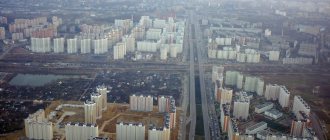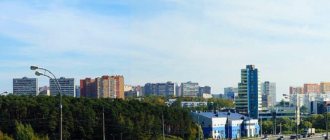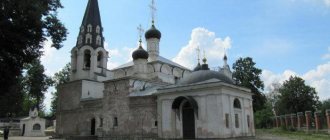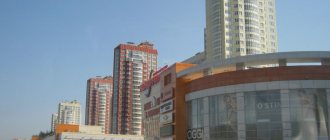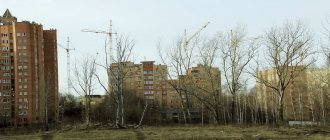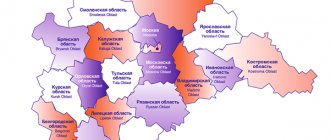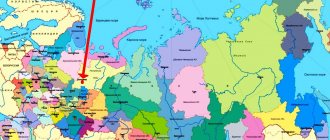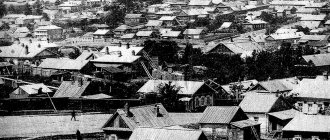| Dolgoprudny |
Dolgoprudny
, a city of regional subordination in Russia, makes up the city district of the same name in the Moscow region, the center of the Dolgoprudny deanery of the Sergiev Posad diocese. Located on the outskirts of the Meshchera Lowland, 20 km north of Moscow. Railway station on the Moscow-Dmitrov line. Population - 104,238 people (2017).
- On the map: Yandex.Map, Google map
The site where the city is now located is marked by two low mounds from the 12th century. Until a certain time, isolated villages and farmsteads were located here, and in the 14th century, manor houses with small settlements appeared. Since the second half of the 16th century, the village of Sterbeevo on the Gnilusha River
(later Gnilusha) has been known;
in 1617, the village of Kurlykovo on the Klyazma River
(later Kotovo) was first mentioned.
The center of the future city was the Vinogradovo estate on Dolgiye Prudy
, so named due to its location at the Dolgiye (“long”) pond, formed by a dammed river. In the 17th century, the estate was owned by G. G. Pushkin, then by his relatives, from 1729 by Prince V. V. Dolgorukov, from 1758 by A. I. Glebov, and from 1790 by E. I. Benkendorf. In 1905, the estate was burned by peasants and rebuilt again in 1911.
At the beginning of the century, a branch of the Moscow-Savelovo railway passed near the village of Vinogradova (Dolgikh Prudov) (now within the city of Kimry). In 1914, the Dolgoprudnaya
.
In 1931, construction of an airship shipyard, a gas plant and other structures for the operation of airships began next to the platform. At the same time, a workers' settlement with predominantly two-story buildings was built. On July 1, 1935, the village was officially classified as a workers' settlement and received the name Dirigiblestroy
. From 1932 to 1937, construction of the Moscow-Volga canal named after Stalin was carried out near the village. On July 15, 1937, the first permanent navigation along the canal opened, which became the western border of the village.
On October 19, 1937, due to the cessation of the construction of airships and the reorganization of production, the workers' settlement was renamed Dolgoprudny
. In 1940, the Central Aerological Observatory began working here. In 1953, the village became the center of the Krasno-Polyansky district.
In 1957, Dolgoprudny received the status of a city of regional subordination, after which housing and cultural construction began to pick up. In the 1950s-1960s it developed as a conglomerate of settlements attached to industrial enterprises and a physical and technical institute. In 1959, the village of Vodniki
, together with the Khlebnikov repair and maintenance base.
In 1963, Dolgoprudny was classified as a city of regional subordination, and the villages of Gnilushi
,
Kotovo
,
Shchapovo
and
Likhachevo
. Since the early 1970s, construction of nine- and sixteen-story buildings has been underway.
In 2003, the village of Khlebnikovo
, the village
of Paveltsevo
and the working village
of Sheremetyevsky
. In 2005, the urban district “Dolgoprudny City” was established, which included only the city itself. At the beginning of the 21st century, the Moscow Institute of Physics and Technology, the Dolgoprudny PATP State Unitary Enterprise State Unitary Enterprise Mostransavto, enterprises of the mechanical engineering, chemical, defense industries, as well as processing and construction enterprises were located in Dolgoprudny; There was a theater supplies factory.
Statistics
- 1939 - 8.0 thousand people
- 1959 - 33 thousand people
- 1970 - 53.1 thousand people
- 1989 - 70.8 thousand people
- 2005 - 77.1 thousand people
Dolgoprudny
Video: Dolgoprudny
Attractions
On the eastern outskirts of the city is the ensemble of the former Vinogradovo estate (XVII-XX centuries), which belonged to G. G. Pushkin, A. I. Glebov, A. I. Benkendorf, E. M. Banza. In the estate complex there is the Church of the Vladimir Mother of God (XVIII century, attributed to M. Kazakov), the Banza house (1913, architect Rylsky), the Herman house (1914, architect Rylsky, abandoned), a horse yard, a cinema club, a cattle barn yard, glacier, dam, gate. Within the city limits is the Mysovo estate (19th century).
- Temple of the Kazan Icon of the Mother of God (2003)
- Temple of the Transfiguration of the Lord (2006)
- Temple of St. George the Victorious (1774)
- Temple of the Savior Not Made by Hands (1684) - tomb of the famous princes Yusupov
- Temple of Tsar-Martyr Nicholas II (1999)
Transport
The city's urban transport is represented by buses and minibuses, including up to four metro lines to Moscow.
Within the city there are four platforms of suburban electric trains of the Savyolovsky direction of the Moscow Railway: Novodachnaya, Dolgoprudnaya, Vodniki and Khlebnikovo, with the help of which you can also get to Moscow. REX stops at the Dolgoprudnaya platform, which gets to Moscow-Butyrskaya (Savelovsky station) in 20 minutes.
Story
The name of the city comes from the name of the Dolgoprudnaya railway platform (built in 1900), whose name, in turn, comes from the Dolgoy (“long”) pond of the Vinogradovo estate, located nearby. At the turn of the 19th and 20th centuries, the surrounding area of Dolgiye Ponds became a dacha destination. Near one of them, the Dolgoprudnaya stop appears, around which the village gradually begins to grow. Soon the so-called “new dachas” appear - somewhat closer to Moscow, near which the Novodachnaya stopping point then appears.
The city of Dolgoprudny owes its birth to the airship-building shipyard, which was built not far from the railway. The working village "Dirizhablestroy" was founded in 1931 on the basis of the center for the construction of airships and the Moscow airshipport. On May 5, 1932, the airship-building plant began work, and already on November 7 of the same year, the airship built on it participated in the parade on Red Square. It was here that the largest airships of the USSR-V series were built. In the 1930s, the outstanding airship builder Umberto Nobile worked at the plant for five years. In 1935, Dirigablestroy received the status of a working village, and in 1938 it was renamed Dolgoprudny; the construction of airships, recognized as unpromising, was suspended. The shipyard was demolished, but the city remained...
From 1932 to 1937, construction of the Moscow-Volga Canal took place through these places. Stalin. The Moscow-Volgostroy and Dmitlag Departments of the OGPU (from 1934 - NKVD) were created. The construction management was located in the Boris and Gleb Monastery in the city of Dmitrov. The construction was carried out by prisoners located in camps along the entire length of the canal... On April 17, 1937, the entire route of the Moscow-Volga canal was filled with water. On July 15, the first permanent navigation along the canal opened.
As part of a large-scale hydroproject, the Klyazminskoe reservoir was created, on the banks of which a working settlement for water workers was built (which became part of Dolgoprudny), which gave the name to the Vodniki stop (in 1951, the platform of the Savyolovsky direction of the Moscow Railway “19 km” was renamed Vodniki).
In 1940, the Central Aerological Observatory began work in Dolgoprudny.
On November 25, 1946, a resolution of the USSR Council of Ministers was issued on the creation in Dolgoprudny of the Faculty of Physics and Technology of Moscow State University named after M.V. Lomonosov, which was reorganized into the Moscow Institute of Physics and Technology on March 17, 1951.
In 1953, Dolgoprudny became the center of the Krasno-Polyansky district, and in 1957 received the status of a city of regional subordination. After this, housing and cultural construction intensified here. In 1963, Dolgoprudny was classified as a city of regional subordination (the villages of Gnilushi, Kotovo, Shchapovo and Likhachevo are included in the city limits). In 1988, the former village of Vinogradovo, located on Dolgiye Prudy (which originally gave the city its name!) was excluded from Dolgoprudny and included in the Severny district of the North-Eastern Administrative District of Moscow.
In 2003, the working village of Sheremetyevsky and the village of Paveltsevo were included in the city of Dolgoprudny.
In the 2000-2010s, the picturesque coastline of the bay in the Vodniki microdistrict was and is being intensively built up. The International Yacht Port appeared here, as well as the luxurious Admiral club and other private clubs, which “cut off” the residential areas of Vodnikov from direct access to the water. The new street, along which fences and checkpoints of these clubs were lined, was helpfully named by the “city fathers” Admiralskaya... And for free recreation, the residents of Dolgoprudny still had a beach area “on the outskirts”.
On October 10, 2014, the Governor of the Moscow Region, Andrei Vorobyov, visited Dolgoprudny. He assured that the coastline near the Klyazma reservoir in the Vodniki microdistrict will be improved by 2016:
“We have the second stage of the improvement project ahead. In Dolgoprudny there is a famous Vodniki beach, it is not well-maintained. We will begin a lot of work in March. About two hundred million rubles will be invested in this from the investor. The beach and coastline will be built to the highest standards. This beach area could be completed by the end of the year.”
- said Vorobyov. The governor clarified that a retaining wall and permanent structures for cafes and recreation will be built on the beach. According to Advisor to the Governor of the Moscow Region Igor Chaika, the beach area in Vodniki will be about 3 hectares and will be divided into three zones - park, cultural and leisure and beach. The embankment will stretch for 370 meters. In the immediate vicinity, the Moskovskie Vodniki microdistrict is already being “outlined,” the project of which will be submitted to the City Council of the Moscow Region in the foreseeable future...
Religion
Until 2008, Dolgoprudny was part of the Dolgoprudny-Khimki deanery of the Moscow diocese. On December 5, 2008, a separate Dolgoprudny dean district was established with its center in the city.
From April 13, 2022, the city of Dolgoprudny belongs to the independent Sergiev Posad diocese within the Moscow Metropolis [1].
Temples
- "Recovery of the Lost", icons of the Mother of God
- St. George the Victorious
- Kazan Icon of the Mother of God
- Nicholas the Wonderworker
- Protection of the Blessed Virgin Mary
- in Dolgoprudny
- in Sheremetyevo
- in Kotovo-Spassky
- in Paveltsevo
Economy and industry of Dolgoprudny
Dolgoprudny is a scientific and industrial center of the Moscow region, where enterprises of the chemical industry, defense and engineering complex, production of building materials and structures operate. The most notable of them are:
- "Dolgoprudny Research and Production Enterprise", which produces weapons for air defense systems.
- The oldest enterprise of the Spetsstroy of the Russian Federation, the Dolgoprudnensky Construction Products Plant, operates in the city.
- In 1956, the Dolgoprudny Automation Design Bureau was opened, now a departmental enterprise of the Ministry of Industry and Trade.
- "Moscow Stone Processing Plant" is engaged in the production of facing materials for locks and embankments of the Moscow-Volga Canal.
The food industry is represented in Dolgoprudny: “Andreevsky confectionery workshops”, “Vegetta” fruit and vegetable base, “Chistaya Liniya” ice cream factory.
Routes on the map of Dolgoprudny. Transport connection
The city network of municipal transport in Dolgoprudny is represented by buses, many of whose routes are duplicated by minibuses.
You can get to Moscow by metro; there are three lines into the city: Zamoskvoretskaya, Serpukhovsko-Timiryazevskaya, Tagansko-Krasnopresnenskaya. You can also get to the capital by suburban trains of the Savyolovsky direction of the Moscow Railway. There are five platforms in the city: Vodniki, Novodachnaya, Dolgoprudnaya, Sheremetyevskaya and Khlebnikovo.
A suburban express train stops at Dolgoprudnaya, reaching Savyolovsky Station in Moscow in less than 20 minutes.
Not far from Dolgoprudny there is Sheremetyevo International Airport.
What can you say about the local infrastructure?
The population is around 104 thousand people. Every year the number of residents increases by about 2 percent. Dolgoprudny is characterized by the presence of a fairly high indicator in such a direction as economic development. All this applies directly to the social infrastructure itself. One of the most famous technical universities is located almost in the central part of the city.
The number of retail spaces here is much smaller than in other similar areas. For example, for each individual resident there is approximately 80 square meters. m. If we talk about Moscow, then the average there is within 257 sq. m. m. Near Dolgoprudny there is a huge shopping center "RIO". This establishment is visited by a huge number of residents of this city.
The industry itself is well developed here. The highest level of providing citizens with much-needed jobs is constantly maintained. There is also a world-famous chemical plant here. It cannot do without a special stone processing plant. Approximately 45 percent of the local working population is employed in the city. You can always get a job at a ship repair yard.
Sights of the city of Dolgoprudny
- The Vinogradovo estate in the Dolgoprudnaya Alley area occupies a large area and includes the Church of the Vladimir Mother of God (18th century), a horse yard, a dam, a cinema club, and neo-Baroque mansions.
- The Temple of the Kazan Icon of the Mother of God is a 50-meter tented Orthodox church that can accommodate up to a thousand people. You can see the two-story building of the temple while sailing past on a pleasure boat along the Moscow Canal.
- Spasskaya Church in Kotovo is the tomb of the Yusupov princes. Located on the shore of the Klyazma Reservoir. Services are held in the current church and a Sunday school operates.
- The Dolgoprudny Historical and Art Museum is the cultural center of the city, where exhibitions, concerts, and creative evenings are held.
Will the city of Dolgoprudny become Moscow in the near future? The closest city to the capital!
Dolgoprudny is a town located in the Moscow region. It is located 18 km from Savyolovsky station. This is one of the closest cities of the capital, which is adjacent to the Moscow Ring Road on the north side. According to numerous estimates of modern experts, this town has simply wonderful prospects for subsequent successful and rapid development:
- Dolgoprudny is located in the top 10 closest cities to Moscow itself. For example, it is less than 5 km from the Moscow Ring Road.
- The town is located in the northern direction, where there is always a minimum number of new buildings. The demand for local real estate here is at a stable level.
- There is an excellent transport interchange. The local social infrastructure is also developed.
All the indicated factors are considered to be a kind of subsistence minimum for the emergence of the real popularity of this wonderful place, as well as for subsequent growth.
Dolgoprudny is characterized by the presence of the following features:
- Location from Moscow - less than 5 km.
- The population is 104 thousand people.
- Working population – 45 percent.
